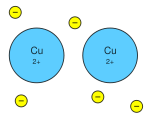Metallic bond

The metallic bond accounts for many physical characteristics of metals, such as strength, malleability, ductility, conduction of heat and electricity, and lustre.
Metallic bonding is the electrostatic attraction between delocalized electrons, called conduction electrons, and the metallic ions within metals. Because it involves the sharing of free electrons among a lattice of positively-charged metal ions, metallic bonding may be compared to that within molten salts.
Metallic bonds are non-polar, because in alloys there is little difference among the electronegativities of the atoms participating in the bonding interaction (and in pure elemental metals, none at all), and the electrons involved in the interaction are delocalized throughout the crystalline structure of the metal.
Metal atoms contain few electrons in their valence shells relative to their periods or energy levels. Such electrons can stray easily from the atoms and become delocalized, forming a sea of electrons permeating a giant lattice of positive ions. The freedom of conduction electrons to migrate gives metal atoms, or layers of them, the capacity to slide past each other, giving rise to metals' typical characteristic phenomena of malleability and ductility.
The electrons and positive ions in metals have a strong attractive force between them. Much energy is required to overcome it. Therefore, metals often have high melting and boiling points. The principle is similar to that of ionic bonds.
Because metals' conduction electrons move independently in a sea of negative charge, metals exhibit electrical conductivity, allowing charge to pass quickly through them, manifested as current. A few non-metals conduct electricity, notably graphite (which, like metals, has free electrons) and molten and aqueous ionic compounds, which have free ions.
Heat conduction works on the same principle; free electrons can transfer energy at a faster rate than the fixed electrons of other substances, such as those which are covalently bonded.[1][2][3]
Metal atoms have at least one valence electron which they do not share with neighboring atoms, nor do they lose electrons to form ions. Instead the outer energy levels of the metal atoms overlap. They are similar to covalent bonds. [4]
References
ar:رابطة فلزية bs:Metalna veza bg:Метална връзка ca:Enllaç metàl·lic cs:Kovová vazba de:Metallische Bindung et:Metalliline side fa:پیوند فلزی ko:금속 결합 it:Legame metallico he:קשר מתכתי sw:Muungo metali hu:Fémes kötés mk:Метална врска nl:Metaalbinding no:Metallbinding nn:Metallbinding simple:Metallic bond sk:Kovová väzba fi:Metallisidos sv:Metallbindning th:พันธะโลหะ uk:Металічний зв'язок Template:WikiDoc Sources